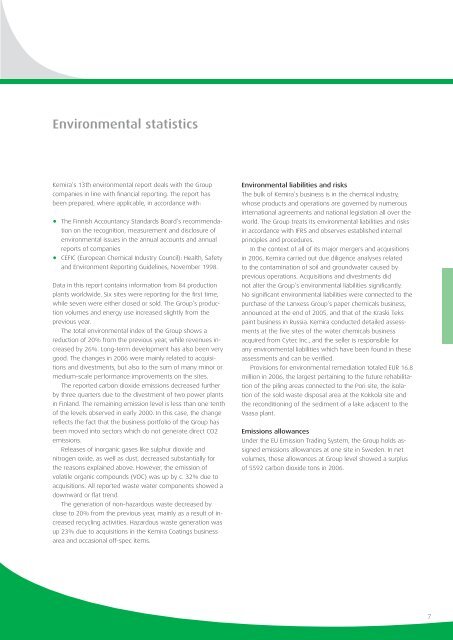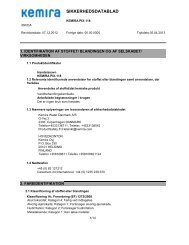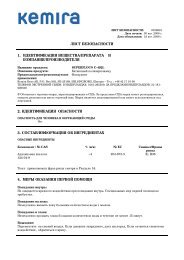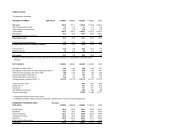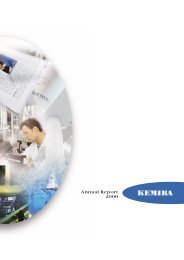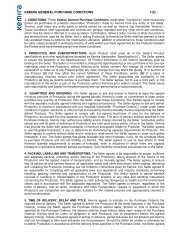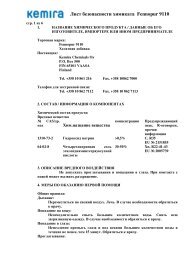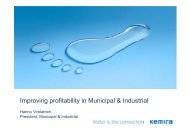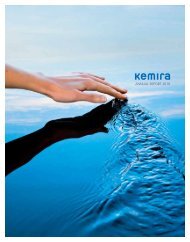Environmental report 2006 (.pdf) - Kemira
Environmental report 2006 (.pdf) - Kemira
Environmental report 2006 (.pdf) - Kemira
Create successful ePaper yourself
Turn your PDF publications into a flip-book with our unique Google optimized e-Paper software.
<strong>Environmental</strong> statistics<strong>Kemira</strong>’s 13th environmental <strong>report</strong> deals with the Groupcompanies in line with financial <strong>report</strong>ing. The <strong>report</strong> hasbeen prepared, where applicable, in accordance with:• The Finnish Accountancy Standards Board’s recommendationon the recognition, measurement and disclosure ofenvironmental issues in the annual accounts and annual<strong>report</strong>s of companies• CEFIC (European Chemical Industry Council): Health, Safetyand Environment Reporting Guidelines, November 1998.Data in this <strong>report</strong> contains information from 84 productionplants worldwide. Six sites were <strong>report</strong>ing for the first time,while seven were either closed or sold. The Group’s productionvolumes and energy use increased slightly from theprevious year.The total environmental index of the Group shows areduction of 20% from the previous year, while revenues increasedby 26%. Long-term development has also been verygood. The changes in <strong>2006</strong> were mainly related to acquisitionsand divestments, but also to the sum of many minor ormedium-scale performance improvements on the sites.The <strong>report</strong>ed carbon dioxide emissions decreased furtherby three quarters due to the divestment of two power plantsin Finland. The remaining emission level is less than one tenthof the levels observed in early 2000. In this case, the changereflects the fact that the business portfolio of the Group hasbeen moved into sectors which do not generate direct CO2emissions.Releases of inorganic gases like sulphur dioxide andnitrogen oxide, as well as dust, decreased substantially forthe reasons explained above. However, the emission ofvolatile organic compounds (VOC) was up by c. 32% due toacquisitions. All <strong>report</strong>ed waste water components showed adownward or flat trend.The generation of non-hazardous waste decreased byclose to 20% from the previous year, mainly as a result of increasedrecycling activities. Hazardous waste generation wasup 23% due to acquisitions in the <strong>Kemira</strong> Coatings businessarea and occasional off-spec items.<strong>Environmental</strong> liabilities and risksThe bulk of <strong>Kemira</strong>’s business is in the chemical industry,whose products and operations are governed by numerousinternational agreements and national legislation all over theworld. The Group treats its environmental liabilities and risksin accordance with IFRS and observes established internalprinciples and procedures.In the context of all of its major mergers and acquisitionsin <strong>2006</strong>, <strong>Kemira</strong> carried out due diligence analyses relatedto the contamination of soil and groundwater caused byprevious operations. Acquisitions and divestments didnot alter the Group’s environmental liabilities significantly.No significant environmental liabilities were connected to thepurchase of the Lanxess Group’s paper chemicals business,announced at the end of 2005, and that of the Kraski Tekspaint business in Russia. <strong>Kemira</strong> conducted detailed assessmentsat the five sites of the water chemicals businessacquired from Cytec Inc., and the seller is responsible forany environmental liabilities which have been found in theseassessments and can be verified.Provisions for environmental remediation totaled EUR 16.8million in <strong>2006</strong>, the largest pertaining to the future rehabilitationof the piling areas connected to the Pori site, the isolationof the sold waste disposal area at the Kokkola site andthe reconditioning of the sediment of a lake adjacent to theVaasa plant.Emissions allowancesUnder the EU Emission Trading System, the Group holds assignedemissions allowances at one site in Sweden. In netvolumes, these allowances at Group level showed a surplusof 5592 carbon dioxide tons in <strong>2006</strong>.7


